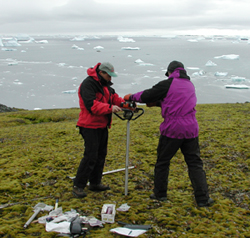Moss brought back to life after 1,500 years frozen in ice
Release Date 17 March 2014

Researchers from the University of Reading and the British Antarctic Survey have brought back to life moss that was frozen in Antarctic ice for over 1,500 years.
This ground-breaking study is the first to show such long-term survival in any plant; similar timescales have only been seen before in bacteria. Previously it was thought mosses, which are known to live in environmental extremes, could only survive for up to 20 years.
The research provides new insight into the survival of life on Earth, including evidence for the possibility of complex life forms surviving in frozen ice and moss's ability to reduce global warming.
The research, published in the journal Current Biology, was conducted at the University of Reading by lead authors Dr Royce Longton and Esme Roads in conjunction with co-author Professor Peter Convey from the British Antarctic Survey.
Professor Convey said: "What mosses do in the ecosystem is far more important than we would generally realise when we look at a moss on a wall here for instance. Understanding what controls their growth and distribution, particularly in a fast-changing part of the world such as the Antarctic Peninsula region, is therefore of much wider significance."
The team took cores of moss from deep in a frozen moss bank in the Antarctic. This moss would already have been at least decades old when it was first frozen. They sliced the frozen moss cores very carefully, keeping them free from contamination, and placed them in an incubator at a normal growth temperature and light level. After only a few weeks, the moss began to grow.
Using carbon dating, the team identified the moss to be at least 1,530 years of age, and possibly even older, at the depth where the new growth was seen. Regeneration also occurred in a liverwort embedded in organic material at the base of the core.
Professor Convey added: "This experiment shows that multi-cellular organisms, plants in this case, can survive over far longer timescales than previously thought. These mosses, a key part of the ecosystem, could survive century to millennial periods of ice advance, such as the Little Ice Age in Europe.
"If they can survive in this way, then recolonisation following an ice age, once the ice retreats, would be a lot easier than migrating trans-oceanic distances from warmer regions. It also maintains diversity in an area that would otherwise be wiped clean of life by the ice advance.
"Although it would be a big jump from the current finding, this does raise the possibility of complex life forms surviving even longer periods once encased in permafrost or ice."
Mosses are an important part of the biology of both polar regions. They are the dominant plants over large areas and are a major storer of fixed carbon, especially in the north.
Dr Royce Longton commented: "This work provides further evidence of the low decomposition rate generally attributed to mosses, and strengthens my conviction that the growth of mosses should be encouraged globally to act as a carbon sink and thus reduce global warming."
ENDS